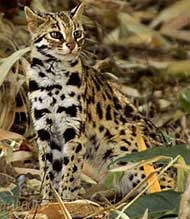| Encyclopedia of Tours and Travel to Meghalaya, featuring information on Fairs & Festivals, Wildlife, Excursion, Adventure and Weather of Meghalaya. |
 |
 |
 |
 |
 |
 |
 |
 |
|
|
Wildlife
Flora Geographical position of Meghalaya has it appears favoured immigration and introduction of different plant species from the neighbouring states of the North Eastern India and also countries like China, Tibet and Burma. Geological factors, like the connection of Meghalaya with the land masses of Peninsular India, the Pacific Islands, Madagaskar and some other portions of Africa might also have influenced Meghalaya's flora and fauna to some extent. A Botanical Wonder The people in the Khasi Hills where the plant grows call it Tiew-Rakot, which means demon-flower or devouring-plant. The Jaintias call it Kset Phare, Kset means net with a lid and Phare means fly. The Garos call the plant Memang-Koksi, which literally means the basket of the devil. The most interesting part of the Pitcher Plant is its leaf. The leaf is modified into different organs, such as the lamina, the tendril, the pitcher and the lid. Over the pitcher, a lid is formed. It is an outgrowth on the face of the leaf near its apex. The lid grows and then become sealed over the mouth of the pitcher. When the plant attains maturity, the lid opens up. The pitcher is designed to catch insects. Money Spinning Plants In Meghalaya forests the rubber-yielding plant of Ficus elastica Roxb. belonging to the family of Moraceae is common. Lac and Gum are obtained from forests in Meghalaya. Meghalayan forests offer tremendous scope for sericulture or silk worm rearing industry. Meghalaya is famous for its honey, derived mostly from forests in beehives. Nowadays, honey is being collected in artificial boxes also, instead of hives on trees. The major crop plants of Meghalaya are Paddy, Maize, Millets, Pulses, Potato, Jute and Mesta, Ginger, Turmeric, Black Pepper, Sugar Cane, Oil Seeds.Both arecanut and betelvine are important cash crops of the State. Khasis are used to chew betel nuts and betel leaves since time immemorial. The Stat Vegetables are grown extensively in the central plateau of the Khasi Hills with loamy soil and also in the plains of the Garo Hills. Recently Tea and Coffee are being grown in lands abandoned after jhuming. Orchids In Cherrapunjee, the two forests - Mawsmai and Mawmluh contain the highest number of orchid species in the whole region. Sohrarim is another forest on the way to Cherrapunjee which is paradise of Botanists. Conservation of orchids is now a matter of universal concern. There is urgent need to maintain orchid sanctuaries and special efforts must be made to protect the 'Sacred forests' of Meghalaya, hitherto preserved by religious sanction alone. 'Orchid banks' may be created in orchidaria or in forest nurseries by bringing endangered species from their natural habitat and displaying them for the public.
Fauna Meghalaya is considered by many biologists to have been the gateway through which many species of Indo-Chinese origin, particularly mammals, migrated to Peninsular India. In the forests of Meghalaya, specially in lower altitudes, multifarious species of birds can be seen in abundance. someare Hoopoe, Long tailed Broadbill, Scarlet Minivet, Burmese Roller , Blue - throated Barbet, Red-vented Bulbul, Himalayan Black Bulbul. Besides, hornbills including the Great Indian hornbill, florican, owl, black drongo and many other birds are also found.Reptile population in Meghalaya includes lizards and snakes, poisonous and non-poisonous. Important ones are Indian Cobra, King cobra, Coral Snake, Vipers. Besides mammals, birds and reptiles, Meghalaya has a number of amphibians and fishes and insects. Amphibians like frogs, toads etc. and fishes like rohu, mrigal, kalibaus, puti and many more of hill stream adaptation are found abundantly in Meghalaya. Among the insect population, ants, flies, bees, beetles are common. Meghalaya's butterflies are world famous, among which are Blue
Peacock, the Karserhed, the Orange Oak Leaf, the Dipper, th Mammals Bulky Body, Subtle Mind The Winged Delights
|
||||||||||
|
||||||||||
|
||||||||||
|---|---|---|---|---|---|---|---|---|---|---|
 e
is basically a home of many horticultural plants such as fruit bearing
trees, cultivated fruit bearing plants, citrus varieties of fruits.
e
is basically a home of many horticultural plants such as fruit bearing
trees, cultivated fruit bearing plants, citrus varieties of fruits. e
Bhutan Glory. It is for this exquisitely diverse, rare and wonderful
animal life that Meghalaya is called a veritable Nature's Wonderland.
e
Bhutan Glory. It is for this exquisitely diverse, rare and wonderful
animal life that Meghalaya is called a veritable Nature's Wonderland.